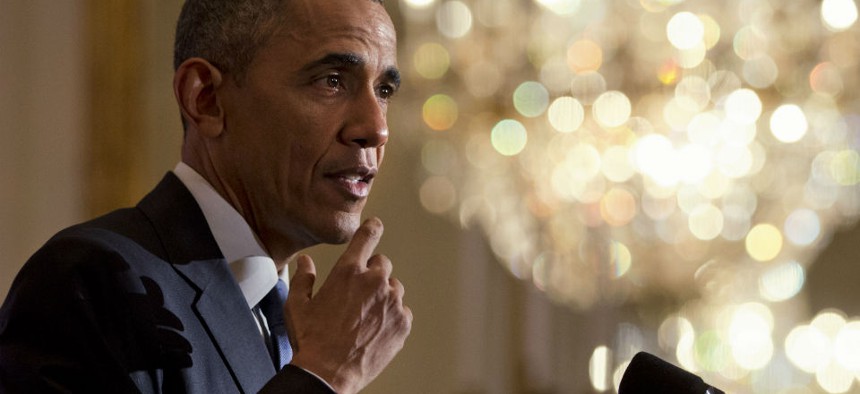
Jacquelyn Martin/AP
Obama Meets With Senior Execs to Encourage ‘Bold and Aggressive’ Reforms
Advisory group is working to make public service cool again.
President Obama joined a group of top leaders in the federal civil service on Thursday at their first full meeting to discuss strategies to improve the Senior Executive Service, focusing on ways to make high-level management positons attractive again.
The meeting of 24 senior leaders, Obama and other administration officials followed several months of subcommittee discussions that have occurred since the White House launched its advisory group in December. The subcommittees were focused on four distinct areas: hiring, recruitment, retention and restoring value to public service.
At the Thursday meeting, Obama encouraged the group to be “bold and aggressive,” and to challenge its “assumptions of things,” according to individuals familiar with his remarks. Obama’s presence was exciting to those involved in the group.
“It means everything,” said Reginald Wells, deputy commissioner for the Office of Human Resources at the Social Security Administration, who is a member of the board but was not able to attend the event. “As with most initiatives, when you have support from the top, you have the basis for moving out in a bold…way.”
Obama last met with the senior executive corps in December, when he thanked the 3,000 leaders in attendance for their service and unveiled a slew of reforms. In addition to the advisory group, Obama announced a new rotational development program and a non-monetary award program.
Wells -- who chairs the subcommittee on restoring value to public service -- said the advisory board is investigating negative stories and other factors that have discouraged individuals in government from joining the SES, and is aiming to rebuild a reserve of federal leadership candidates.
“We want to make sure there is always a pipeline of talented people looking to take on the mantle of leadership in federal government,” Wells said. “The issues the federal government deals with are very complex and require that we provide leadership that is equal to addressing those challenges.”
He added that “some very talented people question if that’s the career path they want to have.”
Wells’ subcommittee has specifically focused on marketing and how to tell the story of the importance of public service. He noted that when Obama came into office it created a lot of optimism he could “make government cool again,” but the president cannot do it all by himself.
Part of that process will involve more public recognition, Wells said. While Obama stressed the need to be bold and innovative, the group is also looking at how to leverage existing infrastructure. The federal executive boards spread throughout the country could be one way government can further recognize regional leadership.
The advisory group has no specific timetable to issue recommendations and is not working toward any singular report. Rather, it plans to offer initiatives to meet the challenges of the SES as its uncovers them. The subcommittee groups will continue meeting on a monthly basis.







